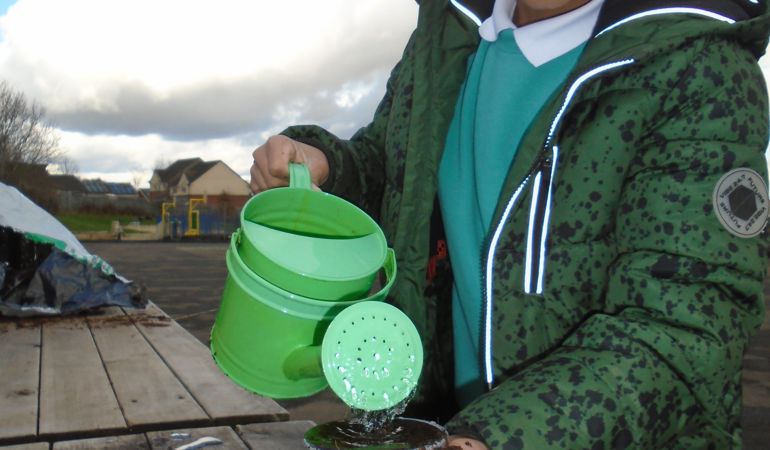Getting green fingered with Greenway Primary

Greenway Primary School serves an urban community in the heart of our capital city, Cardiff. The school is surrounded by housing and roadways making its grounds a valuable green space for playing, relaxing and learning. Recognising this the school committed to making sure the green space worked as hard as possible in encouraging pupils to actively learn about food production and gardening, via the Edible Playground Scheme – a partnership between Cardiff Council, Grow Cardiff, and Trees for Cities.
Enough money from the school budget was ringfenced, allowing for dedicated time to plan how gardening activities would deliver curriculum linked learning. This has flowered into the pupils at Greenway Primary getting their hands dirty 5 afternoons a week, with their teacher and gardener in residence, Simon Evans, leading them up the garden path to imbue them with lifelong gardening and food growing skills.
Karen Clarke, our Lead Specialist Advisor: Education & Lifelong Learning, spoke to Simon to learn more.
“I also cover supply needs for colleagues who are unwell or out of class for any reason, and this saves the school a good portion of the money that is spent on having me as an extra teacher. I have always been keen on gardening and nature. I used to have an allotment, and I helped develop the Year 1 and 2 outdoor area during my time as the Year 1 teacher. I think using teachers' specialisms in a more directed way, is going to be the way forward in primary schools, as it is in secondaries. We have a very forward-thinking Head who is very good at seeing opportunities and instigating strategies outside the usual norms.”
All the classes are involved in gardening on a fortnightly rotation, with their learning experiences tracked and assessed. Simon has developed a practical sheet to monitor children's learning, linked to one or more cross AoLE Progression Steps in the Curriculum for Wales. It links in with Taith360, an online tracking tool linked to the new curriculum. There are infinite possibilities for learning through gardening and Simon points out that “I think gardening is of vital importance to children, so that they really value where our food comes from and acknowledge the work and time that goes into growing and harvesting it. Gardening also has an amazingly calming, grounding effect on behaviour and is fantastic for general well-being.”
The school is lucky to have a good amount of outdoor space. Nursery and Reception share an outdoor area, using a large, raised allotment bed. Year 1 and 2 share a large outdoor area, including some vegetable beds, and a covered set of raised beds within a wire cage to keep the birds at bay. They also have a herb garden and are developing a pollinator bed. There is an orchard of fruit trees to one side, growing apples, pears, plums, mirabelles, quinces and medlars. The Edible Playground of raised beds is on the main concreted yard, and each class from Reception to Year 6 has a bed that they are responsible for. There is a potting shed nearby.
During the first full year of planting the school trialled as many vegetables as possible, including lettuces, peas, tomatoes, broad beans, French beans, runner beans, broccoli, cauliflowers, globe artichokes, sweetcorn, pumpkins, marrows, courgettes, parsnips, carrots, swedes, beetroot, radishes, salsify, spinach, Swiss chard, squash, mangetout, leeks, onions, garlic, potatoes, Brussel sprouts, kale, kohlrabi, celeriac, horseradish and more. As well as the orchard fruits they grew strawberries, raspberries, blackcurrants, redcurrants, gooseberries, white currants, jostaberries and rhubarb. The wide range of fruits and vegetables was to try to encourage the children to widen their experience, and not just go for the carrots! But Simon will evaluate what’s worked and what hasn’t with the pupils as time goes on.
The children pick and prepare all the produce themselves and are slowly becoming more willing to try new foods. Simon has found that involving the children in making familiar foods like sorbets, or crispy 'seaweed' from cabbage or kale, is an added incentive to give new things a try. He also predicts that cookery skills will become an increasingly important part of the curriculum in future years and is keen for the children to develop skills and knowledge in utilising these with the produce they have harvested.
The biggest challenge that Simon has encountered so far is time and timings - time to sow, plant, grow and harvest when nature demands, and timings to ensure the children see the whole process. Simon has developed a kind of 'go-to' sheet to help him plan, outlining the possible jobs to do each month such as in April: sow chitted potatoes. He and the children are very thankful that school staff are able to help by take home trays of seedlings over the school holidays, and shared watering duties over the summer holidays.
Simon keeps communications open, saying “All the activities are posted on the school website and on Twitter, so parents are kept informed of the latest activities. Staff are kept aware of what is happening when I withdraw children from class. And everyone can check out the annotated photo albums, which are updated fortnightly. Everybody seems very supportive.”
Top tip from Simon is to look for support from more experienced colleagues, community members, friends and family, if you lack gardening know how. And a great tool is the Royal Horticultural Society website, where you can simply search by plant for all the information needed, from how and when to sow, through to maintenance, and when to harvest.
